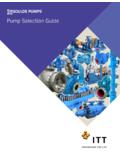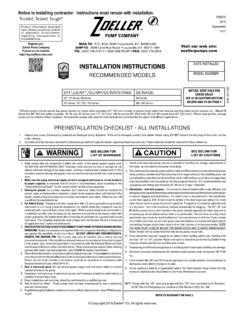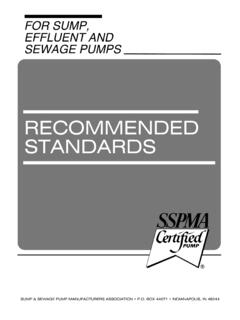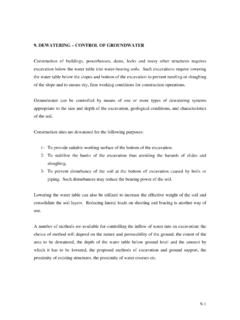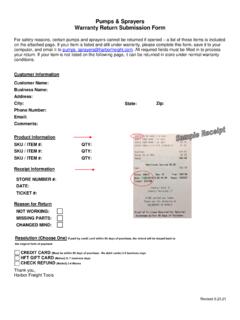Transcription of CHAPTER 3: PUMPING STATION 3.1 INTRODUCTION
1 Part B: Operation and Maintenance3 - 1 CHAPTER 3: PUMPING STATIONCHAPTER 3: PUMPING INTRODUCTIONP umping stations are either as in-line for lifting the sewage from a deeper sewer to a shallow sewer or for PUMPING to the STP or the out fall. They are required where low lying development areas cannot be drained by gravity to existing sewerage infrastructure, and/or where development areas are too far away from available sewerage infrastructure to be linked by gravity. The O&M of PUMPING systems presented here applies to all such types of PUMPING stations.
2 TYPES AND STRUCTURE OF PUMPING STATIONSThe type of PUMPING stations can be (a) Horizontal pumps in dry pit, (b) Vertical pumps in dry pit, (c) Vertical pumps in suction well and (d) submersible pumps in suction sump . All these types include a sewage-receiving sump , which is called suction sump or wet well. These types of pump arrangements are shown in Figure Source: CPHEEO, 1993 Figure Typical drywell and wetwell Dry PitThe size of the dry pit should be adequate for the number of pumps planned and should be such as to handle the sewage load at the desired PUMPING capacity.
3 Allowance should also be made for future requirements of additional or larger pumps. In the configuration, (a) separate dry pit and wet well are required: one to hold the sewage, and one to house the pumps and appurtenances. This option is required for installations where the pumps will otherwise need separate priming and where-as otherwise long suction pipes are needed. Part B: Operation and Maintenance3 - 2 CHAPTER 3: PUMPING STATIONIt is typically used to pump large volumes of raw sewage, where uninterrupted flow is critical and sewage solids could clog suction piping.
4 It is also used to pump solids in pipe galleries between digesters or other solids-handling equipment. While construction costs may be higher and a heating, ventilation and cooling system is necessary when installed below the floor level, this configuration is best for O&M activities because operators can see and touch the Suction sump or Wet WellSewage sump is a compartment or tank in which sewage is collected. The suction pipe of a pump may be connected to the wet well or a submersible pump may be located in the wet well.
5 Sewage sump design depends on the type of PUMPING STATION configuration ( submersible or dry well) and the type of pump controls (constant or variable speed). Wet wells are typically designed to prevent rapid pump cycling but small enough to prevent a long detention time and associated odour sumps should always hold some level of sewage to minimise odour release. Bar screens or grinders are often installed in or upstream of the wet well to minimise pump clogging problems. Instead of manually operated screens at the bottom, which requires the staff to get down into the screen sump , it is better to install mechanical bar screens, which can automatically remove the screenings and lift the same safely above the ground level.
6 There can also be two such screens one after the other for coarse screenings and fine screenings. This will require rectangular channels to maintain longitudinal non-turbulent linear Lift StationsIn general, lift stations are invariably used in gravity sewer network where depth of cut of sewers poses a problem in high water prone areas. The procedure is to sink a wet well on the road shoulder or an acquired plot after the shoulder and divert the deeper sewer there. The submersible pump will lift the sewage and discharge it to the next on line shallow sewer.
7 This is a very useful practice in such locations. Equipment located in the wet well should be minimized, including suction and discharge valves, check valves, or other equipment that require routine, periodic maintenance. This equipment can be located in separate and suitable dry pits located adjacent to the wet well to facilitate accessibility and maintenance for the Operation and MaintenancePumping machinery is subjected to wear & tear, erosion and corrosion due to its nature of functioning, and therefore it is vulnerable to failures.
8 Generally, failures or interruptions are mostly attributed to PUMPING machinery rather than any other component. Therefore, correct operation and timely maintenance and upkeep of PUMPING stations and PUMPING machinery are of vital importance. Sudden failures can be avoided by timely inspection, follow up actions on observations of inspection and planned periodical maintenance. Downtime can be reduced by maintaining inventory of fast moving spare parts. Obviously due attention needs to be paid to all such aspects for efficient and reliable functioning of PUMPING B: Operation and Maintenance3 - 3 CHAPTER 3: PUMPING Operation of the PumpsThe following points should be observed while operating the pumps.
9 A. Dry running of the pumps should be avoided. B. Centrifugal pumps if installed with negative suction should be primed before starting. C. Pumps should be operated only within the recommended range of the head-discharge characteristics of the pump. If pump is operated at a point away from duty point, the pump efficiency normally reduces. Operation near the shut-off point should be avoided, as it causes substantial recirculation within the pump, resulting in overheating of sewage in the casing and consequently, overheating of the pump.
10 D. As far as possible positive suction is to be provided to avoid priming during design itself. E. Voltage during operation of the pump-motor set should be within 10 % of the rated voltage. Similarly, current should be below the rated current shown on the name plate of the motor. F. When parallel pumps are to be operated, the pumps should be started and stopped with a time lag between two pumps to restrict change of flow velocity to minimum and to restrict the dip in voltage in the incoming feeder and should be adequate to allow the pump head to stabilise.










